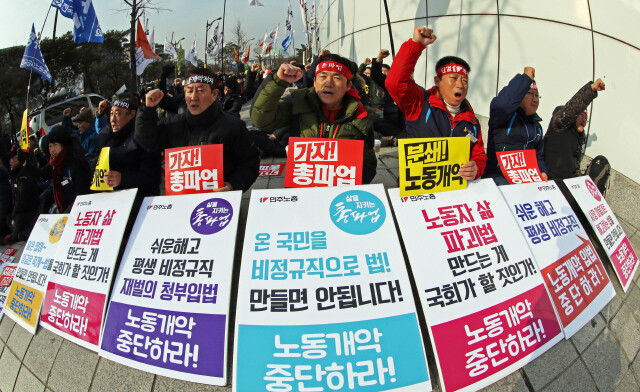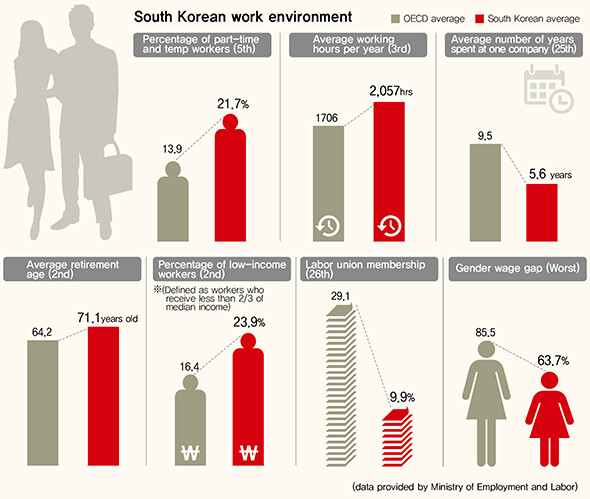hankyoreh
Links to other country sites 다른 나라 사이트 링크
OECD stats paint dismal picture of South Korean working environment

The fate of South Korean workers is to eke out a meager living while hopping from job to job and working late into the night. Compared with other countries who are members of the OECD (Organization for Economic Co-operation and Development), the plight of South Korea’s workers becomes even clearer.
On Dec. 22, South Korea’s Ministry of Employment and Labor published a pamphlet that compiles a number of statistics about the country’s labor market.
A section of the pamphlet that compares last year’s labor and employment statistics for OECD members shows that the average time that South Korean workers spend at one company, 5.6 years, is the shortest in the OECD.
The average amount of time in the 25 OECD countries for which statistics were available was 9.5 years. The period of time that wage earners spend at the same company is an index that can be used to determine the flexibility of the labor market.
South Korean wage earners spend more time on the clock than in most other OECD countries. In 2014, South Koreans worked an average of 2,057 hours, which was third highest after Mexico (2,327) and Chile (2,064). The OECD average is 1,706 hours.

South Korean workers spend 755 more hours on the job each year than German workers (1,302), who work the least of any in the OECD.
In terms of the average hours worked of all the employed - including not only wage earners but also the self-employed - South Korea ranked second (2,124 hours), after Mexico (2,228). The OECD average in this category is 1,734 hours.
South Korean workers keep working even when they get old. The actual age at which South Koreans retire from the labor market is 71.1 years for men and 69.8 years for women, with the age for men second to Mexico (72) and the age for women second to Chile (70). This means that workers in Mexico and South Korea are competing for the title of who will work the most - and the longest - in their lives.
The average retirement age in the OECD is 64.2 years. The countries in which people retire the earliest are Belgium, Austria and Slovakia, at 59 years. The reason that South Koreans retire so late is because the country’s inadequate pension and welfare systems mean that they do not have enough income in their old age.
The indices for wealth distribution did not look any better. South Korea’s wage share (the income of labor as a percentage of the gross domestic product) was 64.8%, or 19th of the 26 OECD countries that tracked the statistic. This means that a higher percentage of the profit produced by economic activity goes to companies than to workers.
There was also a severe gap within the labor market. The low-income workers rate in South Korea was 23.9%, which was second highest in the group after the US (25.3%). The OECD average was 16.4%.
The low-income workers rate refers to the percentage of workers who receive less than two thirds of the median income (defined as the income made by the worker in the middle if all wage-earners were lined up from lowest- to highest-paid).
South Korea’s gender wage gap was also the highest in the OECD. When the median income for male workers is assumed to be 100, the median income for female workers was only 63.7, the lowest figure among 22 countries. This tracked well below not only the OECD average of 85.5 but also the second lowest country in the group, Japan (73.5).
The employment rate for women in South Korea was 54.9%, much lower than the OECD average of 61.1% and 27th of 34 countries.
South Korea had a real minimum wage of US$14.60 (converted to US dollars by applying the real purchasing power exchange rates), which is not much different from the OECD average of US$15.20. However, the minimum wage only stood at 31.5% of the average wage, which placed South Korea 18th among 25 countries.
South Korea also ranked 5th among 29 countries in the percentage of workers with non-permanent positions, which include part-time and temp jobs. 21.7% percent of South Korean workers had such jobs, much higher than the OECD average of 13.9%.
South Korea’s labor union membership rate was at 9.9%, just 26th out of 29 countries. This was only one third of the OECD average of 29.1%, and contrasted sharply with European countries such as Iceland (83%), Finland (69%), Sweden (67%) and Denmark (67%).
By Jeon Jong-hwi, staff reporter
Please direct questions or comments to [english@hani.co.kr]

Editorial・opinion
![[Column] Season 2 of special prosecutor probe may be coming to Korea soon [Column] Season 2 of special prosecutor probe may be coming to Korea soon](https://flexible.img.hani.co.kr/flexible/normal/500/300/imgdb/original/2024/0426/3317141030699447.jpg) [Column] Season 2 of special prosecutor probe may be coming to Korea soon
[Column] Season 2 of special prosecutor probe may be coming to Korea soon![[Column] Park Geun-hye déjà vu in Yoon Suk-yeol [Column] Park Geun-hye déjà vu in Yoon Suk-yeol](https://flexible.img.hani.co.kr/flexible/normal/500/300/imgdb/original/2024/0424/651713945113788.jpg) [Column] Park Geun-hye déjà vu in Yoon Suk-yeol
[Column] Park Geun-hye déjà vu in Yoon Suk-yeol- [Editorial] New weight of N. Korea’s nuclear threats makes dialogue all the more urgent
- [Guest essay] The real reason Korea’s new right wants to dub Rhee a founding father
- [Column] ‘Choson’: Is it time we start referring to N. Korea in its own terms?
- [Editorial] Japan’s rewriting of history with Korea has gone too far
- [Column] The president’s questionable capacity for dialogue
- [Column] Are chaebol firms just pizza pies for families to divvy up as they please?
- [Column] Has Korea, too, crossed the Rubicon on China?
- [Correspondent’s column] In Japan’s alliance with US, echoes of its past alliances with UK
Most viewed articles
- 1[Column] Season 2 of special prosecutor probe may be coming to Korea soon
- 2‘We must say no’: Seoul defense chief on Korean, USFK involvement in hypothetical Taiwan crisis
- 3Is N. Korea threatening to test nukes in response to possible new US-led sanctions body?
- 4Division commander ordered troops to enter raging flood waters before Marine died, survivor says
- 5Amnesty notes ‘erosion’ of freedom of expression in Korea in annual human rights report
- 6Is Japan about to snatch control of Line messenger from Korea’s Naver?
- 7No good, very bad game for Korea puts it out of Olympics for first time since 1988
- 8[Editorial] Korea’s surprise Q1 growth requires objective assessment, not blind fanfare
- 9N. Korean delegation’s trip to Iran shows how Pyongyang is leveraging ties with Moscow
- 10Korea’s 1.3% growth in Q1 signals ‘textbook’ return to growth, says government